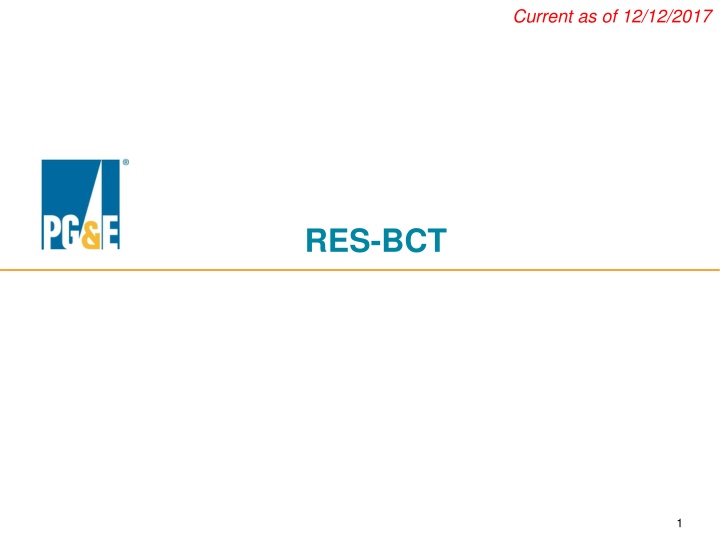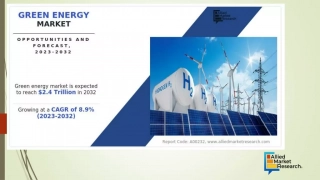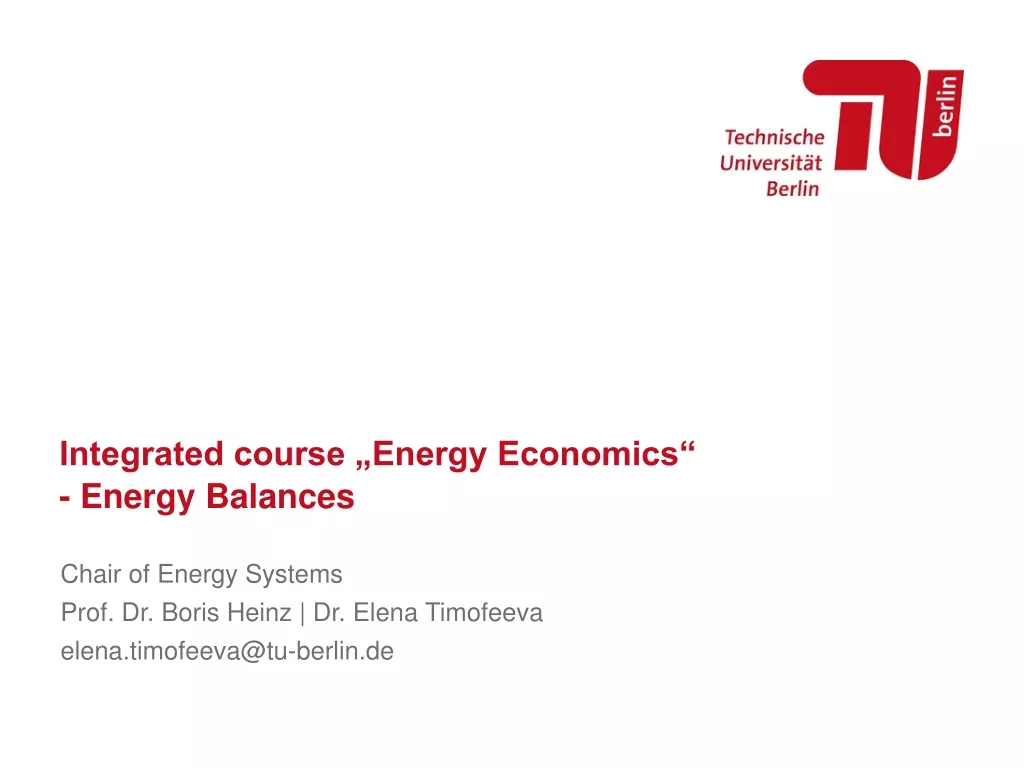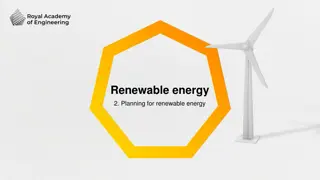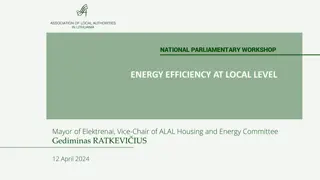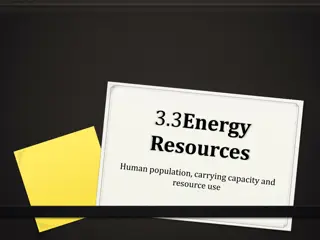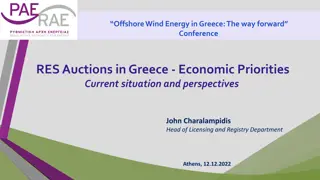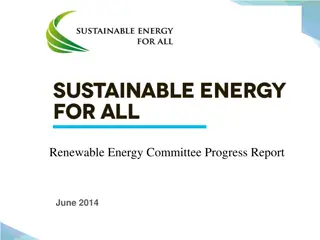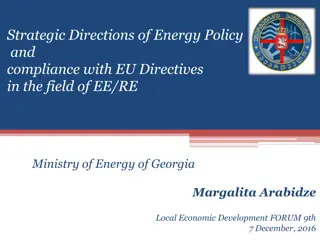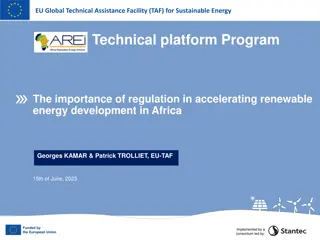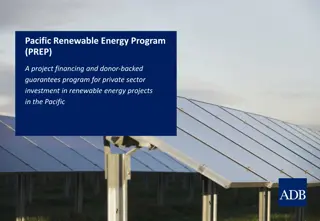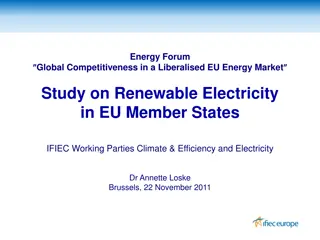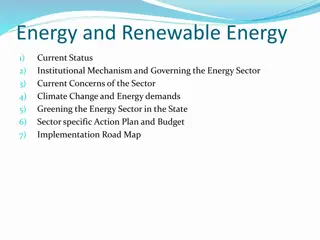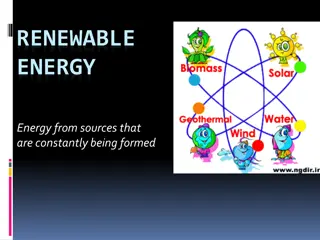RES-BCT Program for Renewable Energy
RES-BCT stands for Renewable Energy Self-Generation Bill Credit Transfer, enabling local governments to export energy to the grid and receive credits. Learn about eligibility, requirements, and benefits of the program.
Download Presentation

Please find below an Image/Link to download the presentation.
The content on the website is provided AS IS for your information and personal use only. It may not be sold, licensed, or shared on other websites without obtaining consent from the author.If you encounter any issues during the download, it is possible that the publisher has removed the file from their server.
You are allowed to download the files provided on this website for personal or commercial use, subject to the condition that they are used lawfully. All files are the property of their respective owners.
The content on the website is provided AS IS for your information and personal use only. It may not be sold, licensed, or shared on other websites without obtaining consent from the author.
E N D
Presentation Transcript
Current as of 12/12/2017 RES-BCT 1
What is RES-BCT? RES-BCT stands for Renewable Energy Self-Generation Bill Credit Transfer. Schedule RES-BCT program allows a Local Government with one or more eligible renewable generating facilities to export energy to the grid and receive generation credits for benefitting accounts of the same Local Government. PG&E s RES-BCT Tariff was approved by the CPUC effective May, 3, 2010. The RES-BCT program cap for PG&E is 105.25 MW. As of the third quarter of 2017, 18.3 MW is interconnected and 47.9 MW is in process. This is explained in more detail on slide 13. 2
Local Government a city, county, whether general law or chartered, city and county, special district, school district, political subdivision, or other local public agency, or a joint powers authority (JPA) formed pursuant to the Joint Exercise of Powers Act that has as members public agencies located within the same county and same electrical corporation service territory, if authorized by law to generate electricity. an individual "Campus" (defined as an individual community college campus, individual California State University campus, or individual University of California campus) of the University of California or the California State University. Local Government is NOT: The state or any agency or department of the state. RES-BCT Applicants must sign a form certifying they meet the definition of a Local Government to enroll. 3
Generating Account Account which serves the eligible renewable generator. Must be no more than 5MW in capacity. Must be on TOU rate. Must take Bundled service. Is interconnected with PG&E s electric system. Meets the Renewables Portfolio Standard (RPS) definition (as defined in PU code section 399.12 e). Is sized to offset part or all of the electricity load (kWh) of the Arrangement. Is not taking service under any other NEM (Net Energy Metering) tariff. The Local Government doesn t sell the exported electricity to the grid to a third party. 4
Benefitting Account Any electric account eligible to receive generation credit elected by the Local Government. Must be located within the geographical boundary of the same Local Government, or for a campus, within the geographical boundary of the city or city and county. Owned, operated, or on property leased by or under the control of the same Local Government. Takes service on a bundled, Time of Use (TOU) rate schedule. Located in PG&E service territory and receives electric service from PG&E. A Local Government can add or delete a Benefitting Account, or reassign the Generating Account or Benefitting Accounts Percentages once a year by providing PG&E 60 days notice. 5
Arrangement Requirements Arrangement is defined as the pairing of a Local Government s Generating Account(s) along with the designated Benefitting Account(s) that will be receiving the allocated export credits. A Local Government can have more than one Arrangement but each Arrangement must have no more than 50 Benefitting Accounts. The Benefitting and Generating Accounts can not be shared between different Arrangements G1 G2B B G= Generating Account B=Benefitting Account B B B B B Arrangement 1 Arrangement 2 6
Case Study: Geographical Boundary Summary: Local government of Mendocino County is in control of properties in Mendocino County (represented by ), and the local government is also in control of one building in Sonoma County (represented by ). Would this arrangement be eligible for RES-BCT? Based on RES-BCT rules, Mendocino County s building in Sonoma County is not eligible since it is not in the same geographical boundary of the same local government The red line shows PG&E territory. Reminder: The local government must be in PG&E territory. 7
Case Study: Campus Summary: Berkeley is a university with multiple locations. It has a Generating Account located at the Berkeley Campus. At which Campuses can the Benefitting Accounts be located? San Francisco Campus Berkeley Campus San Mateo Campus Berkeley Campus is eligible to have Benefitting Accounts. San Francisco and San Mateo Campuses are not. All Generating and Benefitting Accounts have to be at one Campus 8
Metering Requirements A Generating Account under RES-BCT must have PG&E TOU metering: Capable of separately registering the flow of electricity in two directions. Capable of allowing PG&E to bill the Generating Account for its usage according to its TOU Otherwise Applicable Schedule (OAS). Capable of allowing PG&E to determine the Monthly Bill Credit for the Generating Account according to its TOU OAS. A Benefitting Account under RES-BCT must have the PG&E meter needed for PG&E to bill the Benefitting Account according to its TOU OAS. 9
Typical Generating Account Metering Net Generation Output Meter (NGOM) is not needed. The meter must be capable of separately registering the flow of electricity in two directions (interval meter). Only the exports from meter are used for credit not the NET May be situated at an existing customer site. PG&E Grid Load M Transformer 10
Costs Application Cost for RES-BCT is $800 The Local Government is responsible for all interconnection costs. The Local Government is responsible for all meter related costs if it does not have the metering necessary to bill on this tariff. The costs associated with the transfer of a Bill Credit shall include all billing-related expenses; which the Local Government is responsible for: Monthly Billing Administrative Charge is $30.00 per Generating Account One time Billing Setup Recovery Charge is $500.00 per Generating Account 11
Important Citations PU Code 2830: all costs associated to the metering shall be the responsibility of the local government for RES-BCT projects. Paragraph 2: A benefitting account receives service under a time-of-use rate schedule. Paragraph 4: The electrical output of the eligible renewable generating facility is metered for time of use to allow calculation of the bill credit based upon when the electricity is exported to the grid. Paragraph 5: All costs associated with the metering requirements of paragraphs 2 and 4 are the responsibility of the local government. Rule 21, Table E2, Sheet 62: All costs associated with interconnection of an Eligible Renewable Facility at the Generating Account are the responsibility of the local government. 12
Allocation of Credits The Utility will ask the Local Government to designate the Benefitting Accounts and percentage allocation per Benefitting Account at the time of interconnection. Energy credits (known as Bill credits ) are calculated monthly by multiplying the TOU generation component (gen comp) of the energy charge in the rate schedule (OAS) for the Generating Account, by the amount of energy(kwh) exported to the grid during the corresponding time period. Each month the credits are allocated to offset Generation charges on the designated benefitting account. The Generating Account may be a Benefitting Account. 13
Example: RES-BCT Allocation LG Account #4 10% Solar Panels at Generating Account Example: Solar Generation at Generating Account = 2000kWh Load at Generating Account = 1000kWh LG Account #3 15% Export from Generating Account = 1000kWh OAS Generation Rate Schedule = $0.10/kWh 1000kWh x $0.10/kWh = $100 Generating Account 50% Generating Account: $50 LG Account #1= $13 LG Account #2= $12 LG Account #3= $15 LG Account #4=$10 LG Account #2 12% LG Account #1 13% LG = Local Government PV Exports are recorded as it flows to the grid. The kWh are valued at the Generating Account TOU OAS, turned into $$$$$, and then allocated as RES- BCT credit for individual tenant accounts 14
True-Up and Changes to Accounts Each month unused Bill Credits are carried over to the following month until the completion of 12 months. At the end of 12 months, any unused Bill Credits are: First, netted (gen credit to gen charges) for each benefitting account over its true-up period (Account True Up) Second, shared among benefitting accounts until all excess credit is allocated against any remaining gen charges; (Arrangement True Up) Any remaining credit after that is zeroed out. A Local Government may elect to change (add/delete) the Benefitting Account(s) or reassign the allocation percentages no more than once per year within a 12-month period. The Utility must be provided with a notice of at least 60 days. 15
Standby and Non By-passable Charges Standby: RES-BCT customers are NOT exempt from Standby charges. Departing Load Charges: RES-BCT customers pay Departing Load Charges on load served by the generator only at the Generating Account. These charges are billed via a separate departing load charge statement each month. The amount of the charge will vary depending on the technology selected. Email TariffAssistanceHotma@pge.com for questions regarding RES-BCT. 16
How to apply and where to learn more Website: www.pge.com/resbct 17
FAQ 18
FAQ Question 1: The current RES-BCT customer (local government) owns a multifamily housing project. The local government pays for the utility bill portion for the common area, but the tenants are paying their own utility bill. Can the local government add the common area and the tenants on their current benefitting accounts? Answer 1: Only the common area is eligible for benefitting account, assuming it is the same name as the local government. The tenants would not be eligible, since the bill is not under the same name as the local government. Question 2: The current RES-BCT customer (local government) has 1MW of solar. They want to add another 2MW of solar. Do they have to submit another application? Who pays for the distribution and transmission upgrades if need be? Answer 2: Since the local government is adding to their current system they need to submit a new application. The local government is responsible for all the costs associated to interconnection including the distribution and transmission upgrades if need be. 19
FAQs Question 3: The current RES-BCT customer (local government) owns a building in a different county and wants to add that building to their benefitting account. Can the local government do that? Answer 3: No, all of the accounts (generating and benefitting accounts) have to be in the same geographical boundary of the local government. Question 4: A local government wants to install 4MW of solar. Some of the local government s benefitting accounts are not on TOU rate. Is that OK? Answer 4: No, all of the accounts (generating and all benefitting accounts) have to be in TOU rate. 20
Where to Learn More Web Tariff Book: (RES-BCT) https://www.pge.com/tariffs/index.page Electric Rate Schedules dropdown menu RES-BCT FAQ www.pge.com/resbctfaqs 21
